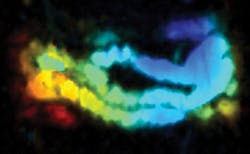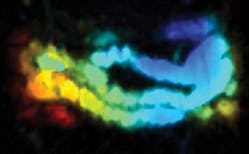Nanoparticles suspended in liquid, ingested by patients, promises to enable photoacoustic tomography (PAT) imaging for a noninvasive, real-time view of the small intestine.1 The advancement could help doctors better identify, understand, and treat gastrointestinal ailments such as irritable bowel syndrome, celiac disease, and Crohn's disease.
To assess the small intestine, doctors typically require patients to drink a thick, chalky liquid called barium. They then image using x-rays, magnetic resonance imaging (MRI), or ultrasound, but these techniques are limited—in terms of safety, accessibility, and lack of adequate contrast, respectively. Also, none effectively provides real-time imaging of movement such as peristalsis, the contraction of muscles that propels food through the small intestine. Dysfunction of these movements may not only be linked to gastrointestinal illnesses, but also be side effects of thyroid disorders, diabetes, and Parkinson's disease.
"Conventional imaging methods show the organ and blockages, but this method lets you see how the small intestine operates in real time," says corresponding author Jonathan Lovell, Ph.D., assistant professor of biomedical engineering at the University of Buffalo (UB), where researchers are pursuing the work.
The researchers worked with a family of dyes called naphthalcyanines—small molecules that are highly light-absorbent in the near-infrared spectrum, which is the ideal range for biological contrast agents. However, the dyes are unsuitable for the human body because they don't disperse in liquid and they can be absorbed from the intestine into the bloodstream. To address these problems, the researchers formed nanoparticles called "nanonaps" that contain the colorful dye molecules and added the abilities to disperse in liquid and move safely through the intestine.
In laboratory experiments with mice, the researchers administered the nanojuice orally. They then used PAT, which uses pulsed laser lights to generate pressure waves that, when measured, provide a real-time and more nuanced view of the small intestine. The researchers plan to continue to refine the technique for human trials, and move into other areas of the gastrointestinal tract.
1. Y. Zhang et al., Nature Nanotechnol., 9, 631–638 (2014); doi:10.1038/nnano.2014.130.

